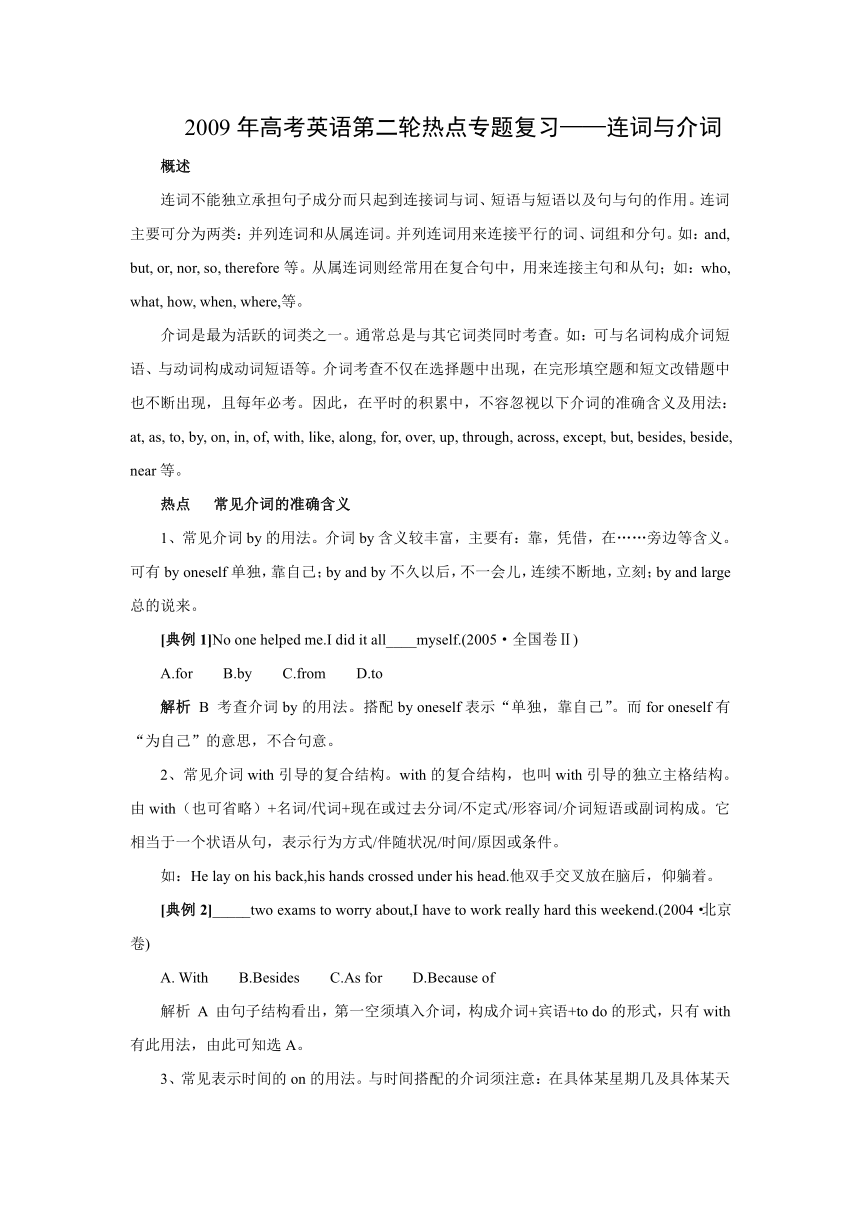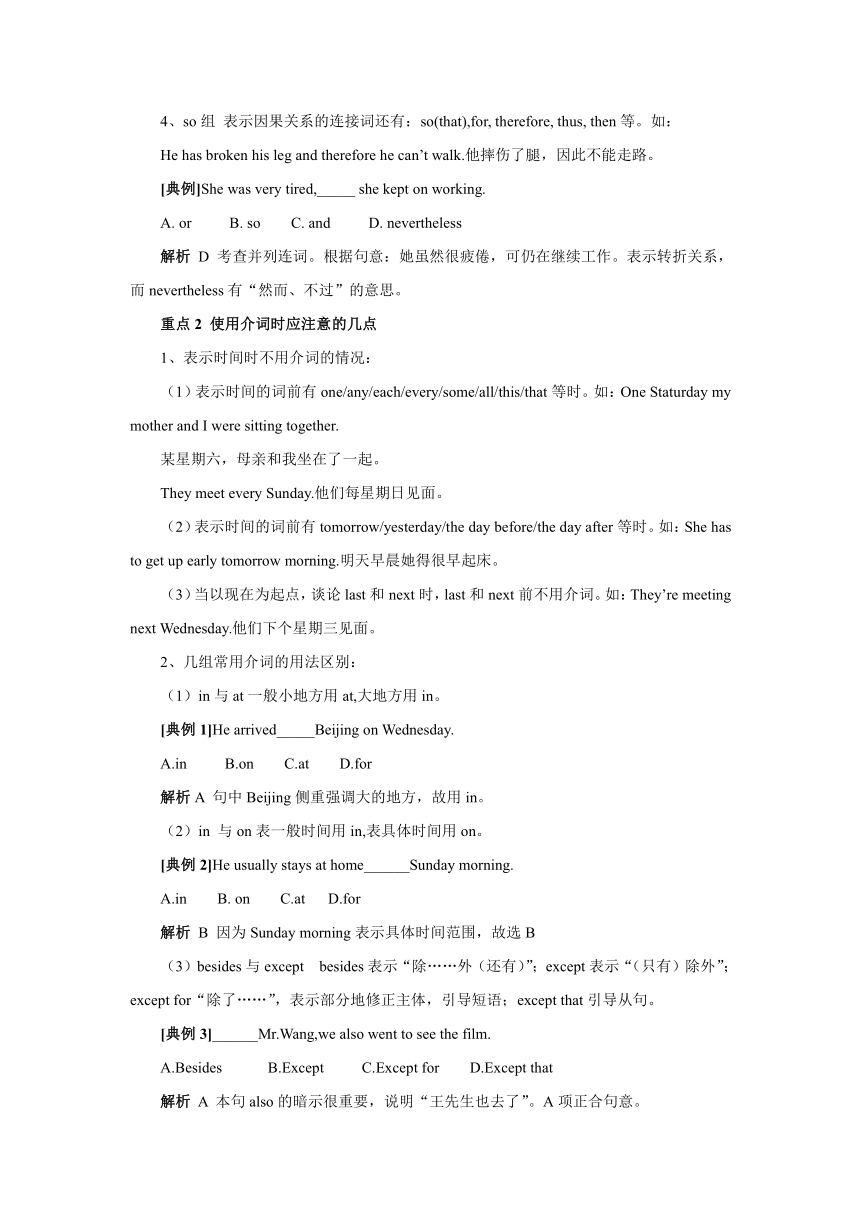2009年高考英语第二轮热点专题复习-连词与介词
文档属性
| 名称 | 2009年高考英语第二轮热点专题复习-连词与介词 |  | |
| 格式 | rar | ||
| 文件大小 | 11.2KB | ||
| 资源类型 | 教案 | ||
| 版本资源 | 通用版 | ||
| 科目 | 英语 | ||
| 更新时间 | 2008-12-05 21:59:00 | ||
图片预览



文档简介
2009年高考英语第二轮热点专题复习——连词与介词
概述
连词不能独立承担句子成分而只起到连接词与词、短语与短语以及句与句的作用。连词主要可分为两类:并列连词和从属连词。并列连词用来连接平行的词、词组和分句。如:and, but, or, nor, so, therefore等。从属连词则经常用在复合句中,用来连接主句和从句;如:who, what, how, when, where,等。
介词是最为活跃的词类之一。通常总是与其它词类同时考查。如:可与名词构成介词短语、与动词构成动词短语等。介词考查不仅在选择题中出现,在完形填空题和短文改错题中也不断出现,且每年必考。因此,在平时的积累中,不容忽视以下介词的准确含义及用法:at, as, to, by, on, in, of, with, like, along, for, over, up, through, across, except, but, besides, beside, near等。
热点 常见介词的准确含义
1、常见介词by的用法。介词by含义较丰富,主要有:靠,凭借,在……旁边等含义。可有by oneself单独,靠自己;by and by不久以后,不一会儿,连续不断地,立刻;by and large总的说来。
[典例1]No one helped me.I did it all____myself.(2005·全国卷Ⅱ)
A.for B.by C.from D.to
解析 B 考查介词by的用法。搭配by oneself表示“单独,靠自己”。而for oneself有“为自己”的意思,不合句意。
2、常见介词with引导的复合结构。with的复合结构,也叫with引导的独立主格结构。由with(也可省略)+名词/代词+现在或过去分词/不定式/形容词/介词短语或副词构成。它相当于一个状语从句,表示行为方式/伴随状况/时间/原因或条件。
如:He lay on his back,his hands crossed under his head.他双手交叉放在脑后,仰躺着。
[典例2]_____two exams to worry about,I have to work really hard this weekend.(2004·北京卷)
A. With B.Besides C.As for D.Because of
解析 A 由句子结构看出,第一空须填入介词,构成介词+宾语+to do的形式,只有with有此用法,由此可知选A。
3、常见表示时间的on的用法。与时间搭配的介词须注意:在具体某星期几及具体某天的上午、下午和晚上等都用介词on。
[典例3]The accident is reported to have occurred_____the first Sunday in February,(2004·上海卷)
A.at B. on C.in D.to
解析 B 考查介词的用法。表示具体某一天的时间时,用on。
4、常见介词as的用法。as作为介词,可表示“充当,作为,如同”。如:She works as a secretary.她担任秘书工作。As a student,it’s bad manners to come late to school.作为一个学生,上课迟到是坏习惯。
[典例4]I feel that one of my main duties_____a teacher is to help the students to become better learners.(2004·广东卷)
A.for B.by C.as D.with
解析 C 考查介词as的用法。本句句意为:我认为作为一名教师,我的主要任务之一就是帮助学生学会学习。
5、常见over的用法。介词over有“在……之上,过之,多于”意思。
[典例5] You can’t wear a blue jacket_____that shirt; it’ll look terrible.(2004·湖南卷)
A. on B. above C. up D. over
解析D 考查介词over 的用法。根据名意可知,此处强调全面覆盖,所以用over,即表示蓝色上衣罩在那件衬衫上。而on表示在硬性物体的表面上;above表示在物体的斜上方;up作介词时,意为“沿……而上”。
重点1 常用的几组并列连词
1、and组表示联合关系。属于这一组的并列连词还有:both…and,not only…but also,as well as,neither…nor等。如:
Let’s go and play basketball.我们去打篮球吧。
2.but组表示转折和对照关系。属于这一组的并列连词还有:however, still, yet ,while, nevertheless。如:
He hasn’t arrived. He may, however, come later.
他还未到,不过,他可能过一会儿来。
3、or组 表示选择关系。属于这一组的并列连词还有:or else,otherwise,neither…nor,either…or等。如:
We’ll go early,otherwise we may not get a seat.我们得早一点去,不然就没有座位了。
4、so组 表示因果关系的连接词还有:so(that),for, therefore, thus, then等。如:
He has broken his leg and therefore he can’t walk.他摔伤了腿,因此不能走路。
[典例]She was very tired,_____ she kept on working.
A. or B. so C. and D. nevertheless
解析 D 考查并列连词。根据句意:她虽然很疲倦,可仍在继续工作。表示转折关系,而nevertheless有“然而、不过”的意思。
重点2 使用介词时应注意的几点
1、表示时间时不用介词的情况:
(1)表示时间的词前有one/any/each/every/some/all/this/that等时。如:One Staturday my mother and I were sitting together.
某星期六,母亲和我坐在了一起。
They meet every Sunday.他们每星期日见面。
(2)表示时间的词前有tomorrow/yesterday/the day before/the day after等时。如:She has to get up early tomorrow morning.明天早晨她得很早起床。
(3)当以现在为起点,谈论last和next时,last和next前不用介词。如:They’re meeting next Wednesday.他们下个星期三见面。
2、几组常用介词的用法区别:
(1)in与at一般小地方用at,大地方用in。
[典例1]He arrived_____Beijing on Wednesday.
A.in B.on C.at D.for
解析A 句中Beijing侧重强调大的地方,故用in。
(2)in 与on表一般时间用in,表具体时间用on。
[典例2]He usually stays at home______Sunday morning.
A.in B. on C.at D.for
解析 B 因为Sunday morning表示具体时间范围,故选B
(3)besides与except besides表示“除……外(还有)”;except表示“(只有)除外”;except for“除了……”,表示部分地修正主体,引导短语;except that引导从句。
[典例3]______Mr.Wang,we also went to see the film.
A.Besides B.Except C.Except for D.Except that
解析 A 本句also的暗示很重要,说明“王先生也去了”。A项正合句意。
(4)in,to与on 表示在某范围之内用in;表示在某范围之外用to;表示“相邻,接壤”时用on.
[典例4]Mongolia lies_____north of China.
A. in B.to C.on D.at
解析 C 根据常识:蒙古国与我国华北接壤,表示“相邻,扫壤”时用on。
难点 使用连词时应注意的问题
1、though/although不能与but同时连用,但可以与yet连用。
[典例1]Though they are so poor ,_____they have enough to eat.
A. so B. and C. but D. yet
解析 Dthough的搭配考查。本句是由though引导,故不能与but同时连用,但可以与yet连用。故选D。
2、because 与so不能同时连用。the reason why…is后通常用that而不用because.
[典例2]The reason why she is fat is_____she overeats.
A. that B.so C.why D.because
解析 A the reason why…is后通常用that而不用because引导表语从句。
3、注意并列连词连接的必须是平行的词、词组、短语或分句。如:
他不但在意大利闻名,而且在美国也很出名。
误:He is not only famous in Italy but also in America.
正:He is famous not only in Italy but also in America.
4、注意某些动词后的连词。
(1)siscuss后一般不跟连词if所引导的从句。
We discussed whether we should close the shop.我们在讨论是否该关店。
(2)doubt后连词的用法 :一般在否定句和疑问句中,doubt后习惯跟that引导的从句;在肯定句中,doubt后面习惯跟whether或if引导的从句。如:
I don’t doubt that you are honest.我不怀疑你的诚实。
I doubt whether/if what he said just now is true.我怀疑他刚说的是否对。
5、whether与if的区别:
(1)表示“如果”时,只能用if。
If he goes, I will go,too.如果他去,我也去。
(2)两者皆表示“是否”时,注意,注意以下几点区别:
①在动词引导的宾语从句后,两者均可使用。
I don’t know whether /if he will come.
但是从句后有or not或者or 时只能用whether。
I don’t know whether he will come or not.
②在介词引导的宾语从句后只能用whether。
③在主语从句、表语从句、同谓语从句中只能用whether。
Whether he will come is not yet known.他会不会来还不知道。
④在不定式前只能用whether。
I can’t decide whether to go or not.我没有决定是否去。
[典例3] What I want to know is ______he will come.
A.that B.不填 C.whether D.if
解析 C 考查表语从句中whether与if的区别使用。在主语从句、表语从句、同谓语从句中只能用whether。
自我检测
1.Mr. Anderson starts to work very clearly in the morning and goes on working until late in the afternoon_____a break at midday.
A.with B.for C.as D.through
2.______the morning of that Saturday,My mother together with me visited my father in prison.
A.In B.On C.At D.To
3.The study you have been making______the ancient Characters is an instructive job.
A. to B. of C. for D. from
4.—What’s your favorite sport
—Jogging. I always run_______the river every morning .
A. around B. on C. along D. in
5.We need fifty more people______our team to do the job.
A. but B. as well C. except D. besides
6. The question of _____she’ll come back home will be setted.
A.if B.whether C.when D.what
7.The last time we had a family reunion was____my brother’s wedding ceremony four years ago.
8. Finding a position in such a big company has always been____his wildest dreams.
9.Between 1975 and 1977,the number of overseas visitors increased_____27%.
A. by B. for C.to D.in
10.Child______she was ,she could do housework for her mother.
A.though B.althogh C.for D.because
11.Does John know any other foreign languages_____French
A.except B.but C.besides D.beside
12._____does he have to type out the answer on a computer,_____he gets the computer to translate it into sounds.
A. Not only;but also B.Either;or
C.Both ;and D.as well as;but
13.When we design a building,we should provide an entrance suitable for wheelchair on the passage,_____lifts,suitable bathrooms and toilets.
A. except B.as well C.as well as D.but
14.Were stories passed on from one person to another Many of the country people could_____read_____write.
A. both; and B. either; or
C. neither; nor D. not only; but also
15.—Would you like to come to dinner tonight
—I’d love to,______I’m too busy.
A.and B.so C.as D.but
[答案与解析]
1、A 介考查介词with结构。即with a break at midday是由“with+宾语+介词短语充当宾补”,在句中作状语。
2、B 强调具体的那个星期六早上。表示在具体某星期几及具体某天上午、下午和晚上等都用介词on。
3、B 考查介词的准确含义。根据句子结构可知you have been making____the ancient Chinese characters作定语修饰the study,由此可以推导:主语the study作making的逻辑宾语,构成make the study of 搭配,相当于动词study,因此此空应选of.
4、C 考查介词的准确含义。第二句:我每天早晨沿着河边慢跑。Jogging意即“慢跑”。介词along表示“沿着”。其它不合句意。
5、D besides表“除……外,还有”; except表“只有……除外”意同but ;as well也。
6、B 根据句子意思“她回不回家这一问题将会解决”可排除C、D;又因whether引导的宾语从句可位于句首,if则不可,故选B。
7、B at one’s wedding ceremony在婚礼。
8、D beyond超出;为……不及。
9、A表示增加或减少常用介词by;to表示增加或减少到。
10、A though引导的让步状语从句除了用陈述句语序外,也可用倒装语序。而although不可用于此句型。
11、C ant other已暗示John了解French.
12 、A not only引导的句子放于句首,要部分倒装,but also部分倒装。
13、C并列连词as well as 表示“也、一样”的意思。
14、D 并列连词not only …but also表示“不但…而且”。
15、D 第二空表示“我想去,但我很忙”。表示转折含义。
概述
连词不能独立承担句子成分而只起到连接词与词、短语与短语以及句与句的作用。连词主要可分为两类:并列连词和从属连词。并列连词用来连接平行的词、词组和分句。如:and, but, or, nor, so, therefore等。从属连词则经常用在复合句中,用来连接主句和从句;如:who, what, how, when, where,等。
介词是最为活跃的词类之一。通常总是与其它词类同时考查。如:可与名词构成介词短语、与动词构成动词短语等。介词考查不仅在选择题中出现,在完形填空题和短文改错题中也不断出现,且每年必考。因此,在平时的积累中,不容忽视以下介词的准确含义及用法:at, as, to, by, on, in, of, with, like, along, for, over, up, through, across, except, but, besides, beside, near等。
热点 常见介词的准确含义
1、常见介词by的用法。介词by含义较丰富,主要有:靠,凭借,在……旁边等含义。可有by oneself单独,靠自己;by and by不久以后,不一会儿,连续不断地,立刻;by and large总的说来。
[典例1]No one helped me.I did it all____myself.(2005·全国卷Ⅱ)
A.for B.by C.from D.to
解析 B 考查介词by的用法。搭配by oneself表示“单独,靠自己”。而for oneself有“为自己”的意思,不合句意。
2、常见介词with引导的复合结构。with的复合结构,也叫with引导的独立主格结构。由with(也可省略)+名词/代词+现在或过去分词/不定式/形容词/介词短语或副词构成。它相当于一个状语从句,表示行为方式/伴随状况/时间/原因或条件。
如:He lay on his back,his hands crossed under his head.他双手交叉放在脑后,仰躺着。
[典例2]_____two exams to worry about,I have to work really hard this weekend.(2004·北京卷)
A. With B.Besides C.As for D.Because of
解析 A 由句子结构看出,第一空须填入介词,构成介词+宾语+to do的形式,只有with有此用法,由此可知选A。
3、常见表示时间的on的用法。与时间搭配的介词须注意:在具体某星期几及具体某天的上午、下午和晚上等都用介词on。
[典例3]The accident is reported to have occurred_____the first Sunday in February,(2004·上海卷)
A.at B. on C.in D.to
解析 B 考查介词的用法。表示具体某一天的时间时,用on。
4、常见介词as的用法。as作为介词,可表示“充当,作为,如同”。如:She works as a secretary.她担任秘书工作。As a student,it’s bad manners to come late to school.作为一个学生,上课迟到是坏习惯。
[典例4]I feel that one of my main duties_____a teacher is to help the students to become better learners.(2004·广东卷)
A.for B.by C.as D.with
解析 C 考查介词as的用法。本句句意为:我认为作为一名教师,我的主要任务之一就是帮助学生学会学习。
5、常见over的用法。介词over有“在……之上,过之,多于”意思。
[典例5] You can’t wear a blue jacket_____that shirt; it’ll look terrible.(2004·湖南卷)
A. on B. above C. up D. over
解析D 考查介词over 的用法。根据名意可知,此处强调全面覆盖,所以用over,即表示蓝色上衣罩在那件衬衫上。而on表示在硬性物体的表面上;above表示在物体的斜上方;up作介词时,意为“沿……而上”。
重点1 常用的几组并列连词
1、and组表示联合关系。属于这一组的并列连词还有:both…and,not only…but also,as well as,neither…nor等。如:
Let’s go and play basketball.我们去打篮球吧。
2.but组表示转折和对照关系。属于这一组的并列连词还有:however, still, yet ,while, nevertheless。如:
He hasn’t arrived. He may, however, come later.
他还未到,不过,他可能过一会儿来。
3、or组 表示选择关系。属于这一组的并列连词还有:or else,otherwise,neither…nor,either…or等。如:
We’ll go early,otherwise we may not get a seat.我们得早一点去,不然就没有座位了。
4、so组 表示因果关系的连接词还有:so(that),for, therefore, thus, then等。如:
He has broken his leg and therefore he can’t walk.他摔伤了腿,因此不能走路。
[典例]She was very tired,_____ she kept on working.
A. or B. so C. and D. nevertheless
解析 D 考查并列连词。根据句意:她虽然很疲倦,可仍在继续工作。表示转折关系,而nevertheless有“然而、不过”的意思。
重点2 使用介词时应注意的几点
1、表示时间时不用介词的情况:
(1)表示时间的词前有one/any/each/every/some/all/this/that等时。如:One Staturday my mother and I were sitting together.
某星期六,母亲和我坐在了一起。
They meet every Sunday.他们每星期日见面。
(2)表示时间的词前有tomorrow/yesterday/the day before/the day after等时。如:She has to get up early tomorrow morning.明天早晨她得很早起床。
(3)当以现在为起点,谈论last和next时,last和next前不用介词。如:They’re meeting next Wednesday.他们下个星期三见面。
2、几组常用介词的用法区别:
(1)in与at一般小地方用at,大地方用in。
[典例1]He arrived_____Beijing on Wednesday.
A.in B.on C.at D.for
解析A 句中Beijing侧重强调大的地方,故用in。
(2)in 与on表一般时间用in,表具体时间用on。
[典例2]He usually stays at home______Sunday morning.
A.in B. on C.at D.for
解析 B 因为Sunday morning表示具体时间范围,故选B
(3)besides与except besides表示“除……外(还有)”;except表示“(只有)除外”;except for“除了……”,表示部分地修正主体,引导短语;except that引导从句。
[典例3]______Mr.Wang,we also went to see the film.
A.Besides B.Except C.Except for D.Except that
解析 A 本句also的暗示很重要,说明“王先生也去了”。A项正合句意。
(4)in,to与on 表示在某范围之内用in;表示在某范围之外用to;表示“相邻,接壤”时用on.
[典例4]Mongolia lies_____north of China.
A. in B.to C.on D.at
解析 C 根据常识:蒙古国与我国华北接壤,表示“相邻,扫壤”时用on。
难点 使用连词时应注意的问题
1、though/although不能与but同时连用,但可以与yet连用。
[典例1]Though they are so poor ,_____they have enough to eat.
A. so B. and C. but D. yet
解析 Dthough的搭配考查。本句是由though引导,故不能与but同时连用,但可以与yet连用。故选D。
2、because 与so不能同时连用。the reason why…is后通常用that而不用because.
[典例2]The reason why she is fat is_____she overeats.
A. that B.so C.why D.because
解析 A the reason why…is后通常用that而不用because引导表语从句。
3、注意并列连词连接的必须是平行的词、词组、短语或分句。如:
他不但在意大利闻名,而且在美国也很出名。
误:He is not only famous in Italy but also in America.
正:He is famous not only in Italy but also in America.
4、注意某些动词后的连词。
(1)siscuss后一般不跟连词if所引导的从句。
We discussed whether we should close the shop.我们在讨论是否该关店。
(2)doubt后连词的用法 :一般在否定句和疑问句中,doubt后习惯跟that引导的从句;在肯定句中,doubt后面习惯跟whether或if引导的从句。如:
I don’t doubt that you are honest.我不怀疑你的诚实。
I doubt whether/if what he said just now is true.我怀疑他刚说的是否对。
5、whether与if的区别:
(1)表示“如果”时,只能用if。
If he goes, I will go,too.如果他去,我也去。
(2)两者皆表示“是否”时,注意,注意以下几点区别:
①在动词引导的宾语从句后,两者均可使用。
I don’t know whether /if he will come.
但是从句后有or not或者or 时只能用whether。
I don’t know whether he will come or not.
②在介词引导的宾语从句后只能用whether。
③在主语从句、表语从句、同谓语从句中只能用whether。
Whether he will come is not yet known.他会不会来还不知道。
④在不定式前只能用whether。
I can’t decide whether to go or not.我没有决定是否去。
[典例3] What I want to know is ______he will come.
A.that B.不填 C.whether D.if
解析 C 考查表语从句中whether与if的区别使用。在主语从句、表语从句、同谓语从句中只能用whether。
自我检测
1.Mr. Anderson starts to work very clearly in the morning and goes on working until late in the afternoon_____a break at midday.
A.with B.for C.as D.through
2.______the morning of that Saturday,My mother together with me visited my father in prison.
A.In B.On C.At D.To
3.The study you have been making______the ancient Characters is an instructive job.
A. to B. of C. for D. from
4.—What’s your favorite sport
—Jogging. I always run_______the river every morning .
A. around B. on C. along D. in
5.We need fifty more people______our team to do the job.
A. but B. as well C. except D. besides
6. The question of _____she’ll come back home will be setted.
A.if B.whether C.when D.what
7.The last time we had a family reunion was____my brother’s wedding ceremony four years ago.
8. Finding a position in such a big company has always been____his wildest dreams.
9.Between 1975 and 1977,the number of overseas visitors increased_____27%.
A. by B. for C.to D.in
10.Child______she was ,she could do housework for her mother.
A.though B.althogh C.for D.because
11.Does John know any other foreign languages_____French
A.except B.but C.besides D.beside
12._____does he have to type out the answer on a computer,_____he gets the computer to translate it into sounds.
A. Not only;but also B.Either;or
C.Both ;and D.as well as;but
13.When we design a building,we should provide an entrance suitable for wheelchair on the passage,_____lifts,suitable bathrooms and toilets.
A. except B.as well C.as well as D.but
14.Were stories passed on from one person to another Many of the country people could_____read_____write.
A. both; and B. either; or
C. neither; nor D. not only; but also
15.—Would you like to come to dinner tonight
—I’d love to,______I’m too busy.
A.and B.so C.as D.but
[答案与解析]
1、A 介考查介词with结构。即with a break at midday是由“with+宾语+介词短语充当宾补”,在句中作状语。
2、B 强调具体的那个星期六早上。表示在具体某星期几及具体某天上午、下午和晚上等都用介词on。
3、B 考查介词的准确含义。根据句子结构可知you have been making____the ancient Chinese characters作定语修饰the study,由此可以推导:主语the study作making的逻辑宾语,构成make the study of 搭配,相当于动词study,因此此空应选of.
4、C 考查介词的准确含义。第二句:我每天早晨沿着河边慢跑。Jogging意即“慢跑”。介词along表示“沿着”。其它不合句意。
5、D besides表“除……外,还有”; except表“只有……除外”意同but ;as well也。
6、B 根据句子意思“她回不回家这一问题将会解决”可排除C、D;又因whether引导的宾语从句可位于句首,if则不可,故选B。
7、B at one’s wedding ceremony在婚礼。
8、D beyond超出;为……不及。
9、A表示增加或减少常用介词by;to表示增加或减少到。
10、A though引导的让步状语从句除了用陈述句语序外,也可用倒装语序。而although不可用于此句型。
11、C ant other已暗示John了解French.
12 、A not only引导的句子放于句首,要部分倒装,but also部分倒装。
13、C并列连词as well as 表示“也、一样”的意思。
14、D 并列连词not only …but also表示“不但…而且”。
15、D 第二空表示“我想去,但我很忙”。表示转折含义。
